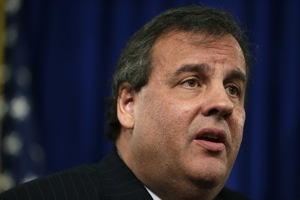Letter: Christie knew of jam
Ex-official: Evidence exists of noticing lanes were closed
Saturday, February 1, 2014
The former Port Authority official who personally oversaw the lane closings on the George Washington Bridge in the scandal now pressing upon Gov. Chris Christie of New Jersey said Friday that “evidence exists” the governor knew about the lane closings when they were happening.
In a letter released by his lawyer, the former official, David Wildstein, a high school friend of Christie’s who was appointed with the governor’s blessing at the Port Authority of New York and New Jersey, which controls the bridge, described the order to close the lanes as “the Christie administration’s order” and said “evidence exists as well tying Mr. Christie to having knowledge of the lane closures, during the period when the lanes were closed, contrary to what the governor stated publicly in a two-hour press conference” three weeks ago.
The letter, which was sent as part of a dispute over Wildstein’s legal fees, does not specify what the evidence was.
In early January, documents revealed that a deputy chief of staff to Christie, Bridget Anne Kelly, had sent an email to Wildstein saying, “Time for some traffic problems in Fort Lee,” the town at the New Jersey end of the bridge, where Christie’s aides had pursued but failed to receive an endorsement from the mayor.
During his Jan. 9 news conference, Christie specifically said he had no knowledge that traffic lanes leading to the bridge had been closed until after they were reopened. “And even then, what I was told was that it was a traffic study,” he said.
The Republican governor’s office said Friday evening that the letter’s claim does not contradict Christie’s statements.
“He had absolutely no prior knowledge of the lane closures before they happened and whatever Mr. Wildstein’s motivations were for closing them to begin with,” Christie’s office said in a statement. “As he said in his Jan. 9 press conference, [Christie] had no indication that this was anything other than a traffic study until he read otherwise the morning of Jan. 8.”
Christie also said last month that his friendship with Wildstein had been overstated and that while the governor had been class president and an athlete, he did not recall Wildstein well from that period and had rarely seen him in recent months.
“I could probably count on one hand the number of conversations I’ve had with David since he worked at the Port Authority,” Christie said at the news conference. “I did not interact with David.”
But The Wall Street Journal recently published photos showing the two men laughing together at a Sept. 11 anniversary event - which happened during the four days the lanes were closed. A high school baseball coach also recalled them as friends.
Christie’s administration has tried to portray the lane closings as the actions of a rogue staff member.
The governor fired Kelly. Wildstein communicated the order to close the lanes to bridge operators. He resigned from his position as the director of interstate capital projects at the Port Authority in early December, saying the scandal about the lane closings in September had become “a distraction.” In a statement that documents show was personally approved by the governor, the administration praised him as“a tireless advocate for New Jersey’s interests at the Port Authority.”
The Port Authority has since refused to pay his legal costs associated with inquiries by the New Jersey Legislature and U.S. attorney into the lane closings.
The letter sent from Wildstein’s lawyer, Alan Zegas, is to the Port Authority’s general counsel, contesting the agency’s decision about the legal fees. Zegas did not respond to requests to further discuss the letter.
The Legislature has sent subpoenas to Wildstein and 17 other people as well as the governor’s campaign and administration seeking information about the lane closings. That information is due Monday.
Kelly’s email was revealed in documents Wildstein submitted in response to an earlier subpoena from the Legislature. But those documents were heavily redacted, leaving clues but no answers as to who else might have been involved in the lane closings.
Some of the documents, for example, showed texts between Wildstein and Kelly trying to set up a meeting with the governor around the time the plan for the lane closings was hatched. But it is unclear what the meeting was about.
Information for this article was contributed by Kate Zernike of The New York Times and by Angela Delli Santi and Geoff Mulvihill of The Associated Press.
Front Section, Pages 3 on 02/01/2014
